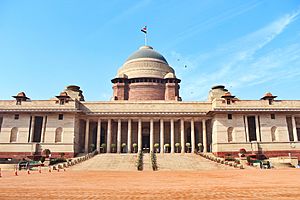Rashtrapati Bhavan facts for kids
Quick facts for kids Rashtrapati Bhavan |
|
|---|---|
| Former names | Viceroy's House |
| Alternative names | Presidential House |
| General information | |
| Architectural style | Delhi Order |
| Location | Rajpath, New Delhi, India |
| Coordinates | 28°36′51.63″N 77°11′59.29″E / 28.6143417°N 77.1998028°E |
| Current tenants | Ram Nath Kovind (President of India) |
| Construction started | 1912 |
| Completed | 1929 |
| Opened | 1931 |
| Technical details | |
| Size | 130 hectare (321 acre) |
| Floor area | 200,000 sq ft (19,000 m2) |
| Design and construction | |
| Architect | Edwin Lutyens |
The Rashtrapati Bhavan is the official home of the President of India. It is located at the western end of Rajpath in New Delhi, India. The name "Rashtrapati Bhavan" means "Presidential Residence" in Hindi. Before India became independent, it was known as the Viceroy's House.
This grand building is not just a house. It is a huge estate that covers 130 hectares (about 320 acres). This makes it the largest residence for any head of state in the world.
Contents
What is Rashtrapati Bhavan?
Rashtrapati Bhavan is much more than just a building. It is a symbol of India's democracy and power. The main building has 340 rooms. These include the President's official living areas, special halls for guests, and offices. This main part is often called the mansion.
The entire Presidential Estate includes many other things. There are beautiful gardens called the Mughal Gardens. There are also large open spaces, homes for the President's bodyguards and staff, stables, and other offices. All these are surrounded by a perimeter wall.
A Grand Home for India's President
The President of India lives and works at Rashtrapati Bhavan. It is where important meetings happen. Foreign leaders and important guests are welcomed here. The President also hosts many ceremonies and events in this building.
It is a place where decisions are made that affect the whole country. It shows the strength and history of India.
Built for a Viceroy
The construction of Rashtrapati Bhavan began in 1912. It was finished in 1929 and officially opened in 1931. It was originally built for the Viceroy of India. The Viceroy was the highest British official in India during the time of British rule.
After India gained independence in 1947, the building became the home of the President of India. This change marked a new era for the country.
Who Designed It?
The famous British architect Edwin Lutyens designed Rashtrapati Bhavan. He worked with another architect, Herbert Baker. Lutyens wanted the building to combine Indian and British architectural styles. He used a special style called the Delhi Order. This style mixes traditional Indian elements with classical European designs.
The building has many unique features. It has domes, pillars, and detailed carvings. These show a blend of different cultures.
Exploring the Estate
The Rashtrapati Bhavan estate is very large. It has many interesting parts beyond the main building.
The Beautiful Mughal Gardens
One of the most famous parts of the estate is the Mughal Gardens. These gardens are inspired by the traditional Mughal style of gardening. They are known for their stunning beauty and variety of flowers.
The gardens are open to the public for a short period each year. Visitors can see thousands of different types of roses, tulips, and other plants. There are also fountains, canals, and lawns.
Important Ceremonies
Many important ceremonies take place at Rashtrapati Bhavan. One well-known event is the Change of Guard ceremony. This is when a new group of soldiers takes over guard duty. The President's Bodyguard, a special cavalry unit, also performs impressive parades here.
These ceremonies are a way to honor the President and show respect for the nation. They are also a chance for people to see the traditions of India.
Images for kids
-
Rayapati Sambasiva Rao, Member of Parliament, presenting U.S. President Barack Obama with a scarf during the State Dinner receiving line at Rashtrapati Bhawan, 2015
See also
 In Spanish: Rashtrapati Bhavan para niños
In Spanish: Rashtrapati Bhavan para niños
















